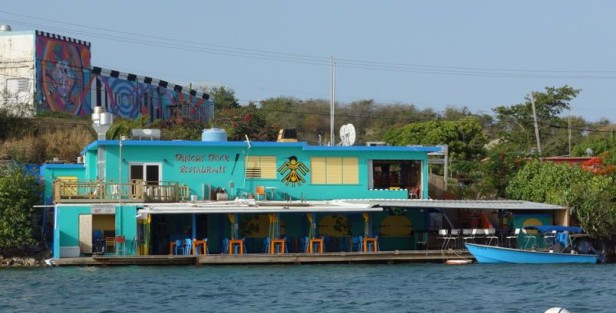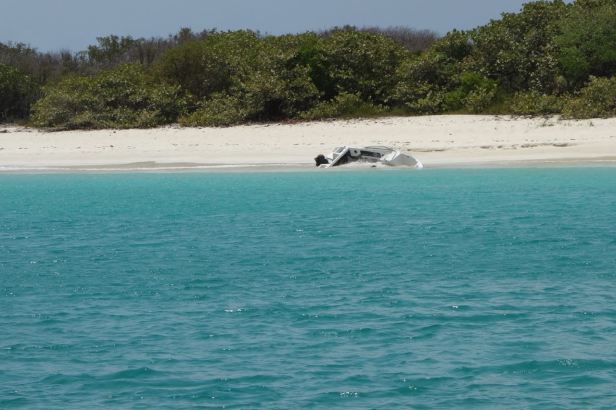(above photo credit:Andrew Bennett, via Flikr)
The sky is gray and the temperature drops into the seventies, feeling cool in the normally hot, steamy mid-eighties of late June in the Caribbean.
We’re in Fajardo on the eastern edge of Puerto Rico at the start of a sailing vacation.
As I steer the catamaran from behind the shelter of the marina breakwater, the seas grow and the wind sprays salt water, stinging my eyes and cheeks. My glasses are useless, too wet to see through. My shirt soaks and sticks to my chest.

How is this happening? I ask myself. I checked the weather this morning – winds were forecasted for high teens to low 20s. In the excitement to get on with my first Caribbean charter in nine years, I hadn’t re-checked the weather.
We are starting our vacation in a tropical thunderstorm.
The wind builds to the mid-thirties. The forty foot, 16,000 lb. yacht is hobby-horsing like a toy. Our 65′ mast whips back and forth. A wave pattern develops. Three or four car-sized crashing waves and then a much larger trough – crash. Repeat.
I glance at the anemometer: 40 knots (46 mph).
On this boat the helm is up high, above the hard bimini that the rest of the crew is sheltering under. Almost everyone else is new to sailing in open water. The three kids are already crying. (Laura tells me our child is “hysterical.”) The adults look worried.
I feel bad for everyone. They’ve traveled all this way from Texas to be hit by scary, ugly weather right out of the gate.
I yell for the crew to repeat anything they say — the wind is too loud to hear them.
My wife, Laura, asks if we should turn back. It’s a possibility but for now I focus on keeping the bows into the wind, goosing the twin diesels and cranking the wheel to keep from being pushed sideways. I know that if I allow the tall, wide hull to turn broadside to the wind things will get even uglier. So I focus on two things: keep the boat headed into the wind and keep the crew safe (from falling overboard, hitting their heads, banging a knee). The two seven-year-olds are in their ocean harnesses.
Seawater weighs 63 lbs. per cubic foot. Fifteen to thirty thousand pounds are crashing into our boat every few seconds.
I’m getting worried. Our crew is inexperienced and this is a fast-hitting, severe storm. Mostly I want to know what’s coming – is it getting worse? From the helm I ask Scott (the other dad in our group) to grab the handheld VHF radio. Then on second thought I decide to use the cell phone. This is very unusual to me — calling from a boat on the cell — but things have changed and the charter company tells me during the briefing that the cell phone is just fine to reach them. So I ask Scott to call the charter duty captain and ask for a forecast update.
In a couple minutes, Scott comes back to the cockpit. “Graham says, ‘Come back.'” I’m a little surprised, but at the moment it seems the best move. It’s not far back to the safety of the marina.
I whip the wheel around and goose the port engine. I do this to spin the cat around quickly, minimizing time spent sideways to the wind and waves. The new course is quieter and calmer. The waves are lifting the stern, but the boat is more stable. In a few minutes we are back inside the heavy marina breakwater, tied up at the dock.
I have learned two valuable lessons: mother nature is always in charge and always recheck the weather before leaving the dock.
After we are settled, the kids are smiling again and the first beers have been cracked, Ziggy from the charter company is on the boat checking things over. The air conditioner pumps need to be bled because of the hard ride. Ziggy saw our mast pitching back and forth in Vieques Sound, so he knows the boat needs some attention. We are all chatting, relieved.
Ziggy emerges from below, looks at me and asks: “What’s the difference between an ordeal and an adventure?” I say “ten knots,” thinking I’m clever.
His answer is better: “Attitude.”
≈≈≈
Our crew of seven ended up having a wonderful time in the Spanish Virgin Islands. The kids, being resilient as kids are, fell in love with the islands. We left again later that day after the storm had passed (and a thorough weather check). On our five-day charter we snorkeled reefs, hiked to a natural “jacuzzi” on Culebrita, saw sea turtles, cooked out on the boat, enjoyed several deserted beaches with crystal blue waters. We ate great seafood at The Dinghy Dock in Dewey on Culebra.
We can’t wait to do it again.







Loved this story. Thanks for sharing.
LikeLike
Thanks Danny. I’m glad you enjoyed it. Hope you and the girls are having a great summer!
LikeLike
Reminds of sailing with my dad! It was not uncommon to run into some type of trouble.
LikeLike
Oh I know what you mean! Thankfully for me it’s only 1 out of 10 times.
LikeLike